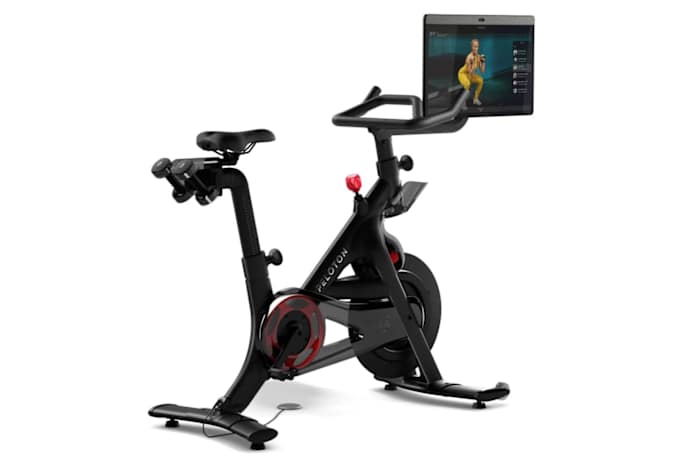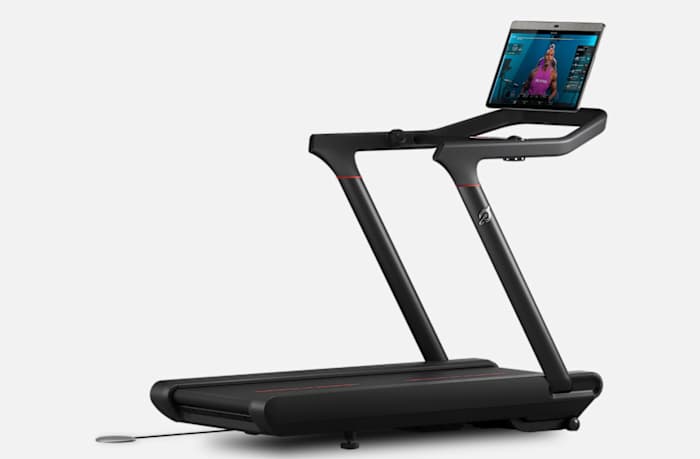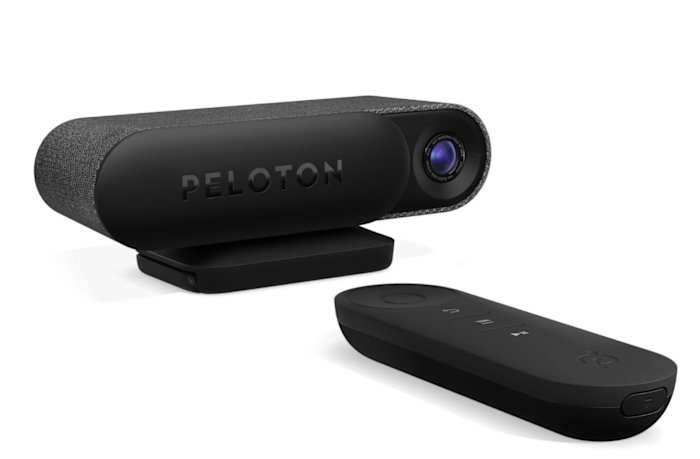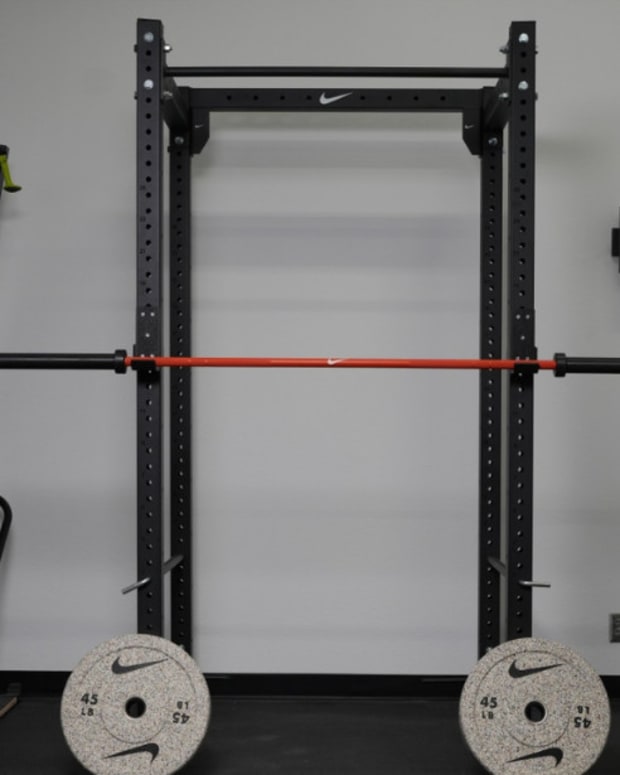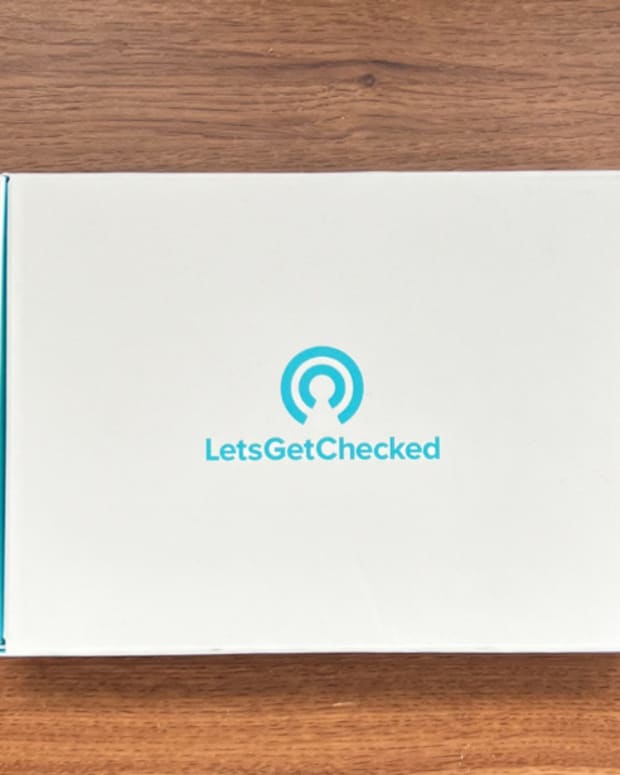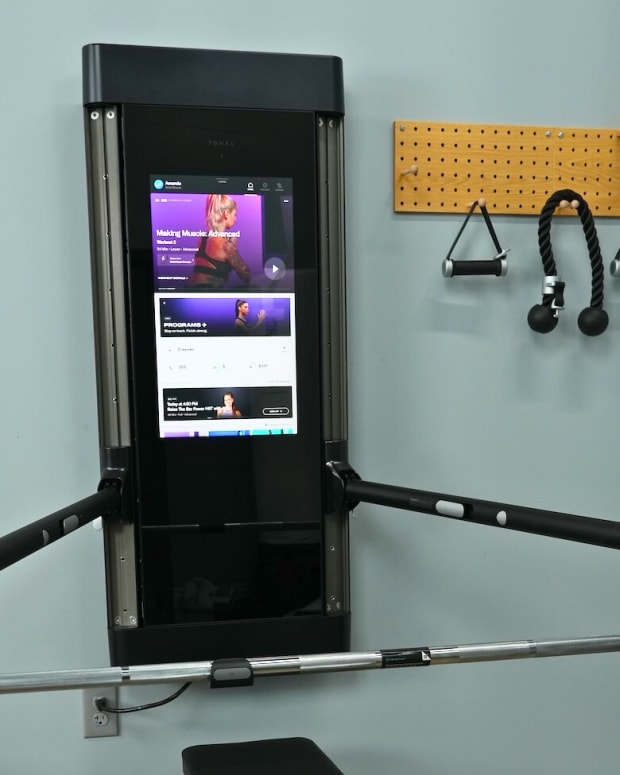The products featured in this article have been independently reviewed. When you buy something through the retail links on this page, we may earn commission at no cost to you, the reader. Sports Illustrated editorial staff are not involved in the creation of this content. Learn more here.
We’re living in the golden age of at-home workout equipment—whether you want to beam yourself into connected group fitness classes or allow smart technology to take the guesswork out of strength training, there’s a machine out there for you. But there are two newer brand names that stand out from the crowd, and pitting Peloton against Tonal is like asking whether cardio or strength training is better.
On one hand, Peloton reinvented the way people think of indoor cycling (and then brought that community-driven magic to indoor running and indoor rowing). But Tonal is making at-home strength training accessible to beginners and experienced lifters alike, replacing IRL instructors and coaches with a machine that determines your fitness level at any given moment.
If you’re waffling between purchasing a Tonal versus Peloton, there’s a lot to consider. Neither of these brands offer machines on the budget end of at-home fitness equipment, and both offer live and on-demand classes, data-rich app experiences and tons of health benefits. But there are important distinctions between Peloton’s machines and Tonal, and understanding your own fitness goals will help you make a decision on where to invest. In the meantime, we can help by explaining the main differences and the pros and cons of Tonal and Peloton.
An Overview of Tonal
Tonal, which launched in 2018, is a wall-mounted all-in-one smart home gym that prioritizes strength training—it essentially looks like a giant iPad with two resistance-generating arms extending from the center console. During workouts, it acts as a personal trainer and spotter: After an initial fitness assessment, Tonal’s algorithms can prescribe suggested weights and automatically adjust them for you, increasing them if you’re flying through reps or decreasing them when you’re struggling to finish. Tonal also uses multiple sensors to track users’ motions and provide real-time form feedback. In addition to strength training classes, users can take live and on-demand classes in high-intensity interval training (HIIT), boxing, dance cardio and more.
Tonal Home Gym
Specs:
- Price: $3,995
- Display: 24-inch HD touchscreen with 15W stereo speakers
- Resistance: 100 pounds per arm
- Dimensions: 21.5 inches wide by 50.9 inches high by 5.25 inches deep
- Weight: 135 pounds
- Connectivity: WiFi and Bluetooth
Pros:
- Takes up very little floor space in your home
- Generates up to 100 pounds of resistance in each arm
- Offers real-time form feedback during exercises
Cons:
- Very expensive upfront and monthly membership costs
- Installation by a Tonal professional is required and relocating is difficult
- 100 pounds per arm may not be enough for very experienced lifters
An Overview of Peloton
Peloton is an exercise equipment company and fitness brand that makes at-home gym equipment and streams immersive studio-style workout classes. The company launched the Peloton Bike in 2012, and since then has produced a more expensive version, the Bike+; a treadmill called the Peloton Tread; a streaming device for strength training called the Peloton Guide and a rower called the Peloton Row. Outside of the workouts designed for each machine, Peloton also offers classes in stretching, bootcamp, yoga, walking and more. Peloton also sells accessories like light weights, dumbbells, water bottles, workout mats, cycling shoes, heart rate bands and earbuds, along with replacement parts like pedals, cleats, touchscreens and more.
Peloton Bike
Specs:
- Price: $1,445
- Display: 21.5-inch HD touchscreen with rear-facing stereo speakers
- Resistance: 100 levels micro adjustable magnetic resistance with mechanical adjustment
- Drive: Belt drive
- Dimensions: 59 inches long by 23 inches wide by 53 inches high
- Weight: 135 pounds
- Maximum User Weight Capacity: 270 pounds
- Pedals: Delta compatible
- Connectivity: WiFi and Bluetooth
Pros:
- Footprint is smaller than a traditional yoga mat
- Belt drive design and magnetic resistance is virtually silent
- Basically replaces a gym membership with All-Access Membership to Peloton app
Cons:
- Separate monthly membership fee (which is required if you want any of the features that make Peloton, Peloton) adds up to $528 per year to already high purchase price
- Touchscreen doesn’t rotate for off-bike classes (the screen on the Bike+ does)
- No automatic resistance adjustments, which you get with the Bike+
Peloton Tread
Specs:
- Price: $3,495
- Display: 23.8-inch HD touchscreen with rear- and front-facing stereo speakers
- Speed: Up to 12.5 miles per hour
- Dimensions: 68 inches long by 33 inches wide by 62 inches high
- Running Belt Size: 59 inches long by 20 inches wide
- Weight: 290 pounds
- Maximum User Weight Capacity: 300 pounds
- Incline: 0 to 12.5 percent
- Connectivity: WiFi and Bluetooth
Pros:
- Max speed of 12.5 miles per hour and max incline of 12.5 percent
- 59-inch running belt length accommodates taller runners
- Easy-to-use knobs on side rails allow for quick speed and incline adjustments
Cons:
- Separate monthly membership fee adds up to $528 per year to purchase price
- Does not fold up for storage
- Oversized screen wobbles at faster speeds
Peloton Guide
Specs:
- Price: $195
- Dimensions: 6.5 inches long by 2.5 inches wide by 2.6 inches high
- Mounting Height: 18 to 84 inches
- Weight: 18 ounces plus 4.4 ounces for mounting bracket
- Camera: 12 megapixels
- Connectivity: WiFi and Bluetooth
Pros:
- Small size allows for portability and use in small spaces
- Provides personalized class recommendations
- Membership is $20 cheaper than All-Access Membership, but still includes access to live and on-demand classes
Cons:
- Requires a TV
- Requires investing in your own strength training equipment
- Does not give form feedback or give weight suggestions
Tonal vs Peloton: App
Tonal App Pros
- In-depth workouts assessments allow you to track reps, sets, time under tension and total workout volume to see your progress over time
- Recommends personalized workouts and programs, and shows you “muscle readiness” based on your latest workout
- Movement library includes video demos and detailed instructions on exactly how to do each move
Tonal App Cons
- Tonal app subscription is very expensive at $59.95 a month
- The number of “on the go” workouts you can do solely on your phone is limited
- Without the app, you lose access to all of the machine’s personalization features
Tonal Classes
Tonal uploads new content every week, not just for strength training but for HIIT, yoga, dance, barre, pre- and post-natal routines, guided meditation and breathwork. You can also join guided multi-week programs based on three goal options—Improve Fitness, Get Lean and Build Muscle (all of which have beginner, intermediate and advanced options)—or sport-specific programs for activities like running, skiing and golfing. Tonal offers live classes, where you train in real time with coaches (just like you would in a studio), and virtual group workouts, which let you sweat with friends and see their reps and metrics in real-time. If you prefer to do your own thing, you can choose from 245 movements to create custom workouts on a single piece of equipment.
Tonal Subscription
To unlock all of Tonal’s personalized features and workouts, you need a Tonal membership, which costs $59.95 a month. The membership is required (no pausing) for the first 12 months, then transfers to a month-to-month payment schedule that can be paused or canceled at any time. Without a monthly subscription, though, you’ll lose access to the machine’s intelligence and personalization features as well as the workout library (all of which justify the high price tag), but you can still use the weight dial to increase or decrease weight and safety features like turning weight on or off via the Smart Handles and Smart Bar.
Peloton App Pros
- Can be used anywhere with a WiFi connection via smartphone, tablet, computer or TV
- Has a massive music library that allows you to choose workouts based on artists or genres, and you can save songs you like and sync them to Apple Music and Spotify
- Doesn’t require a Peloton machine; the app-only membership costs $12.99 a month
Peloton App Cons
- All-access membership, which is necessary to use with equipment, is expensive at $44 a month
- Many classes require equipment, which must be purchased separately
Peloton Classes
Peloton offers live and on-demand workouts in 16 different exercise genres, from boxing and rowing to meditation and stretching. Users can filter classes by goals, music taste, experience level and schedule (classes range from five to 90 minutes), and stream classes to their machine, phone, tablet and TV. On the Bike or Tread, Peloton classes include a leaderboard that allows you to see how you rank against other people who have taken or are taking that same class; Peloton also offers programs that include progression-based classes, recommended schedules and progress reports.
Peloton Subscription
For full access to Peloton’s live and on-demand classes on any of their machines, you’ll need to sign up for an All-Access membership that costs $44 a month. A Guide-only membership costs $24 a month. If you don’t have any Peloton equipment, you can also sign up for an app-only membership that costs $12.99 a month. If you have a machine but don’t want to pay the monthly cost (which kind of negates the investment), you can use the Just Ride/Run/Walk/Row modes, all of which offer basic cycling, running, walking or rowing experiences without an instructor, and still join two pre-recorded classes.
Tonal vs Peloton: Brand Comparison
Peloton was created to bring the immersive experience of cycling classes (and now running, rowing and all other kinds of workouts) into your home—some of the instructors have reached celebrity-level status and the Peloton community is almost cult-like. Tonal, on the other hand, is meant to replace working one-on-one with a personal trainer, and uses science-backed algorithms and insights to provide real-time feedback and post-workout assessments to help you maximize each training session.
Tonal vs Peloton: Which is better for weight loss?
Weight loss, at its simplest, is a matter of burning more calories than you consume. And cardio burns more calories than weight training. That said, cardio and strength training are crucial for weight loss. Strength training helps you build muscle, and muscle burns more calories than fat. You also burn more calories post-strength training than after a cardio workout, thanks to a phenomenon called excess post-exercise oxygen consumption (EPOC), AKA the afterburn effect.
But if weight loss is your main goal, then cardio should be a priority—and Peloton, not Tonal, makes cardio machines. The Peloton app also offers off-machine strength-building workouts like resistance training and bootcamp, so you’re getting the best of both worlds in terms of class opportunities, whereas Tonal’s main cardio offering at the moment is HIIT classes.
Tonal vs Peloton: Which is better for muscle growth?
Muscle growth requires progressive overload, meaning you need to gradually increase the intensity or difficulty of workouts over time. You can absolutely make Peloton’s cardio workouts harder as your fitness improves, but strength training with heavy weights is a quicker way to make gains.
While running and biking definitely help strengthen specific muscles (like your quads and calves and hamstrings), Tonal’s movement library includes 245 exercises that target every muscle group so you can strengthen your entire body. Tonal’s extendable arms also provide up to 100 pounds of resistance each, which allows users to progressively (and intelligently, thanks to the machine’s smart algorithms) increase the amount of weight they use in workouts to promote muscle development.
Peloton does offer strength training classes, and the Guide was designed to connect to your TV so you can stream the company’s library of strength content. But the small camera only allows you to see yourself next to the trainer so you can mimic proper form, and it doesn’t come with any equipment that you could use for strength training; you’d have to invest in weights separately.
Tonal vs Peloton: Which is better for cardio?
While you can take high-intensity interval training classes—a great form of cardio—via Tonal, a Peloton Bike or Tread is definitely a better cardio investment.
HIIT is a style of anaerobic exercise—meaning you’re working out at 80 to 95 percent of your max heart rate for short bursts of effort followed by periods of recovery—that does have cardiovascular benefits (one 2016 study determined that five weeks of HIIT improved people’s VO2, AKA your muscles' ability to use oxygen). But any form of cardio can be turned into a HIIT workout, whether that’s bodyweight training or sprinting on an exercise bike or treadmill or rower.
Peloton’s machines allow for HIIT and steady state cardio, during which you exercise at 45 to 65 percent of your maximum heart rate—a continuous lower-to-moderate intensity workout. Steady state cardio is crucial to improving endurance and cardiovascular fitness, and if your priority is aerobic improvement (i.e. you’re training for a running race or cycling adventure), time on feet or time in the saddle is more important than ripping through a short, intense workout.
Tonal vs Peloton: Cost and value
The Peloton Bike is the most affordable of these machines (not counting the $295 Peloton Guide) at $1,495, compared to the starting price of the Peloton Tread and Tonal, which is $3,995. FYI: It’s very easy to drive that cost up even further by adding on bike shoes, heart rate monitors and other accessories from Peloton, or the $495 accessories bundle from Tonal. And then you have to add on subscription costs: $44 a month for the Peloton Bike or Tread, or $59.95 a month for Tonal.
That sounds like a lot of money, but the cost of in-person fitness classes adds up, too; Twice weekly spin classes at around $20 per class will cost you $160 a month. When you look at the math that way, you’re getting more bang for your buck with Peloton. Tonal’s membership gives you tons of personalized feedback when using the machine, but a Peloton subscription gives you access to classes no matter how you work out—on a bike, treadmill, rower or sans equipment.
Tonal vs Peloton: Warranty and customer service
Peloton offers a limited warranty for the Bike that covers the HD touchscreen, pedals, labor and all other components for 12 months, and the frame for five years; for the Tread, you get 12 months of coverage for the HD touchscreen, components and labor; five years for the frame; and three years for the drive motor and walking belt. You can purchase protection plans that cover an additional 48 months for the Bike and Tread for $199 to $249. The Guide is covered in full for 12 months, and an additional 24 months of protection costs $24. Tonal’s warranty includes one year of coverage for parts and labor, and two additional years for parts only. Accessories get one year of coverage.
Both brands are marketed as high-end at-home fitness equipment, but their customer service leaves something to be desired. Peloton’s customer service has generated a number of complaints online, regarding contacting the company and issues with delivery and returns. Tonal requires professional installation in order to avoid safety and product issues, and seems to be more proactive about responding to complaints with the product. Both companies offer a 30-day home trial and return window where users are eligible for a full refund.
FAQs
Does Tonal have bike workouts?
No. In addition to strength training, Tonal offers classes in barre, bootcamp, boxing, cardio, dance cardio, family fitness, golf, high-intensity interval training, kickboxing, meditation, mobility, Pilates, pre- and post-natal, recovery and yoga. You can also use it to create custom workouts.
Can you use Tonal and Peloton without subscriptions?
Yes—but you’re not going to get the same experience. Canceling your Tonal membership (which is required for 12 months) cuts your access to all of the machine’s AI-drive personalized features, but you can still use its resistance. With a Peloton subscription, you’ll only be able to take two pre-recorded classes and use the machines in the most basic mode.
Does Tonal sell equipment other than the smart home gym?
No. Tonal only sells the smart home gym, although it does sell accessories to go along with the main machine, including smart handles, which are equipped with six-axis gyroscopes to track reps and a button that allows you to change the weight; a smart bar that also allows you to turn weight on or off; a rope for pulling exercises; a weight bench; a roller and a workout mat.
Final Thoughts
At the end of the day, the question of Peloton vs Tonal comes down to your specific fitness goals and what kind of experience you’re looking for in working out at home. If you crave community or you're working on improving your aerobic fitness, a cardio machine like the Peloton Bike or Tread will be a better investment (and the Peloton membership will still give you access to strength training classes). But if you’re looking to make gains and are fine doing cardio on your own, a smart machine like Tonal will go a lot further in helping you develop your strength.
Prices are accurate and items in stock as of publish time.


